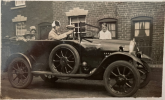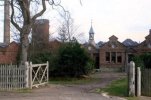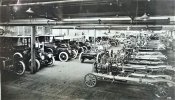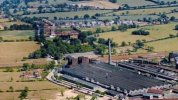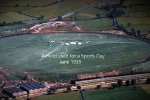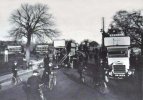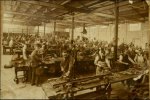great photo mike...hard to imagine it once looking like that...trying to work out todays view...we can clearly see the train tracks on your 1937 map and your red arrow marks the spot where the photo was taken showing the bridge over the river rea. here is todays view of the train station on longbridge lane so i assume the photo was taken just a little further down from the station...difficult to be precise as the area has changed so much ..lyn

-
Welcome to this forum . We are a worldwide group with a common interest in Birmingham and its history. While here, please follow a few simple rules. We ask that you respect other members, thank those who have helped you and please keep your contributions on-topic with the thread.
We do hope you enjoy your visit. BHF Admin Team
You are using an out of date browser. It may not display this or other websites correctly.
You should upgrade or use an alternative browser.
You should upgrade or use an alternative browser.
Longbridge Factory
- Thread starter Pamelawagster
- Start date
What was the name of the paint supply company you worked for? Can you remember if yellow was supplied to Longbridge?In addition to Wellingborough, Beans and Coventry (Morris Engines), cylinder blocks and heads were supplied by West Yorkshire foundry in Leeds. In the 1970's and 1980's, I worked for the company that supplied the different coloured block and head paints for all of these sites.
Cabonscooter
proper brummie kid
Only just found this this thread on this site. Caught my eye as although I wasn't employed by Austin-Rover/MG Rover I spent 2/3 days (sometimes nights as well) a week over 15 years at Longbridge as a Honeywell contractor looking after the energy controls and BMS or what Longbridge called CEMS (Central Energy Management System). I got to know a huge number of people everywhere as I had to visit pretty well all parts of the works and offices North/South/East and West.
Reading the hisory of Longbridge it appears that The Cofton gearbox works was built quite late which I hadn't realised and isn't shown on a lot of maps.
Sadly, now all gone which I'm constantly reminded of when my wife likes to go shopping there.
Alan Marriott
Reading the hisory of Longbridge it appears that The Cofton gearbox works was built quite late which I hadn't realised and isn't shown on a lot of maps.
Sadly, now all gone which I'm constantly reminded of when my wife likes to go shopping there.
Alan Marriott
Velox Chris
New Member
Hi there! I have lived quite close to the Longbridge works since 1995 and have seen many changes, although I have never worked there. I remember Lowhill Lane and most of the surrounding roads being clogged up with parked cars when the factory was fully functioning. Then when everything went wrong and the place closed in 2005 the area suddenly became a bit of a ghost town almost overnight. I know people who lost there jobs but were lucky enough (or so they thought) to gain similar employment at the Peugeot plant at Ryton. Having sold up and moved to the Coventry area many of them lost their jobs again after a very short time when Peugeot then pulled the rug out from under them for a second time. It ruined many people after selling their houses at a loss as house prices in the Longbridge area plummeted, and taking out a fresh mortgage in Coventry only to then face the threat of re-possession. Gradually house prices around Longbridge came back up as over the years it was seen as a nice quiet area to move to on the edge of the countryside for those who had alternative jobs.
Regards, Chris.
Regards, Chris.
Velox Chris
New Member
Hi there! I was always fascinated by the building known as the 'Flight Shed' at the lower end of Lowhill Lane. It seemed an unusual place to have what seemed to be a WW2 aircraft hangar, until I gradually began to uncover and understand the fascinating history of the factory and the part it played during the war years. I used to drive past it every day on my way to work and often used to go for walks and would purposely go and have a closer look at it through the railings. If one was to stand on the grass bank on the other side of the road in Cofton Park, you could get a good view of the inside of the geodexic roof structure through the windows that ran around the upper edge of the building. It looked a bit like the fuselage of a Wellington bomber but on a massive scale.
I was lucky enough to meet a chap at one of the Longbridge car rallies in Cofton Park who told me of a great web site called 'Austin Memories', which has been formed by a dedicated group of local historians keen to preserve and promote the rich history of the factory and the social history surrounding it. On the website. if you go onto the list at the side of the screen and click on 'Aircraft Production', then scroll down to the very end there is the most amazing piece of film showing the production of Hawker Hurricanes in the Flight Shed during WW2. Full airframe assembly is shown being carried out as well as the installation of Rolls Royce Merlin engines (by people who look as though they may have once lived in my street) and in the upper background the roof structure can clearly be seen. It then shows the completed aircraft being carried up onto the airfield via a lift type platform which ran on rails up the hillside at the rear of the building. The film ends with a Hurricane being flown out from the airfield with a clear view of a hill in the near distance with a clump of trees on the top (Frankley Beeches).
These were not the only aircraft built at the Longbridge factory. Across the road (Groveley Lane) from the flight shed was another less obvious aircraft hangar where Avro Lancaster fuselages were built and shipped out by road for final assembly elsewhere. Other aircraft built there was the Fairey Battle, and sub-assemblies for the De Haviland Mosquito. This building was later to be used for engine developement and gearbox production in the post war years, and I believe right up to the end of the factory's involvement with BMW, whereupon it was demolished to make way for housing.
One day as I drove past the flight shed, I noticed a sign attached to the railings saying that a demolition company was on sight with work having already begun. As I work in the motor vehicle heritage sector, I informed my work colleague who looked quite shocked. Being fully aware of it's historical significance he quickly got in touch with the demolition company and arranged for us to go and salvage a piece of the roof structure, as only two examples of this type of hangar roof survived in Britain at that time; Longbridge, and the old Supermarine factory at Southampton which was then occupied by Ford and where Transit vans were being produced.
We went with a Land-Rover and car trailer, and in very wet weather managed to come away with an entire 'diamond' section with adjoining sections and cross bracing spars which had already been chomped out by the demolition machine which resembled a huge mechanical dinosaur. Seeing this section close up, it became obvious how much bigger it was than when it was up in the roof and that it was going to overhang the entire trailer by quite a bit! The whole roof structure was held together by thousands of huge stubby looking nuts and bolts, the threads of which were very fine. These bolts had a diameter of approx. 2 1/4" inches and approx 3" inches long. There were about three dozen of these bolts in the bit we had salvaged, and we were just wondering how on earth we were going to transport this huge steel thing as we had no tools with us of this size to dis assemble it, when I discovered that all these bolts were in fact loose and the nuts could just be unscrewed by hand! Such was the quality of these fixings that none of them were seized up or even rusted, the only obstacle being to break the creamy coloured paint coating on some of them to undo them. It turns out through our research that luckily for us the fixings were never tightened when the roof was built in the 1930's, but purposely left loose to allow for a precise amount of expansion and contraction. So fortunately we were able to stack all the individual pressed sections neatly (which were about nine feet long and heavy) and which still filled the whole trailer. Incidentally, as we studied each individual section we began to appreciate the complexity of the design and the result of some very clever and precise design calculations. These must have been worked out by someone with a slide-rule and incredible engineering abilities, to allow for the gentle curvature of the roof span which was governed entirely by the subtle variation in the bolt hole positions and the angles of the pressed sections.
While we were there, amongst the rubble we stumbled upon the remains of where the hillside lift had been installed, in a large rectangular concrete hole in the ground which had been covered over with a steel girder structure and plating. This had been cut out for scrap revealing some of the original mechanism which had probably not seen the light of day in seventy years.
The roof section was re-assembled when we got it back to work where it was displayed in an exhibition about 'Shadow Factories' and what the car factories did towards the war effort in ww2. As far as I can recall, the roof section went out on loan to the British Motor Museum at Gaydon where I believe it may currently be in storage.
The site of the Flight Shed at Longbridge is now occupied by a housing estate with road names which only offer a clue as to it's aviation history. and I have since learned that the Supermarine factory building has also now gone, demolished in the name of progress. There were also some entrances to the factory's vast network of underground tunnels uncovered and which were all sealed off prior to the houses being built.
I have since learnt that the Supermarine factory building has also been demolished in the name of progress.
If anyone out there has any other interesting information on any of these buildings I would love to know.
Kind regards, Chris.
I was lucky enough to meet a chap at one of the Longbridge car rallies in Cofton Park who told me of a great web site called 'Austin Memories', which has been formed by a dedicated group of local historians keen to preserve and promote the rich history of the factory and the social history surrounding it. On the website. if you go onto the list at the side of the screen and click on 'Aircraft Production', then scroll down to the very end there is the most amazing piece of film showing the production of Hawker Hurricanes in the Flight Shed during WW2. Full airframe assembly is shown being carried out as well as the installation of Rolls Royce Merlin engines (by people who look as though they may have once lived in my street) and in the upper background the roof structure can clearly be seen. It then shows the completed aircraft being carried up onto the airfield via a lift type platform which ran on rails up the hillside at the rear of the building. The film ends with a Hurricane being flown out from the airfield with a clear view of a hill in the near distance with a clump of trees on the top (Frankley Beeches).
These were not the only aircraft built at the Longbridge factory. Across the road (Groveley Lane) from the flight shed was another less obvious aircraft hangar where Avro Lancaster fuselages were built and shipped out by road for final assembly elsewhere. Other aircraft built there was the Fairey Battle, and sub-assemblies for the De Haviland Mosquito. This building was later to be used for engine developement and gearbox production in the post war years, and I believe right up to the end of the factory's involvement with BMW, whereupon it was demolished to make way for housing.
One day as I drove past the flight shed, I noticed a sign attached to the railings saying that a demolition company was on sight with work having already begun. As I work in the motor vehicle heritage sector, I informed my work colleague who looked quite shocked. Being fully aware of it's historical significance he quickly got in touch with the demolition company and arranged for us to go and salvage a piece of the roof structure, as only two examples of this type of hangar roof survived in Britain at that time; Longbridge, and the old Supermarine factory at Southampton which was then occupied by Ford and where Transit vans were being produced.
We went with a Land-Rover and car trailer, and in very wet weather managed to come away with an entire 'diamond' section with adjoining sections and cross bracing spars which had already been chomped out by the demolition machine which resembled a huge mechanical dinosaur. Seeing this section close up, it became obvious how much bigger it was than when it was up in the roof and that it was going to overhang the entire trailer by quite a bit! The whole roof structure was held together by thousands of huge stubby looking nuts and bolts, the threads of which were very fine. These bolts had a diameter of approx. 2 1/4" inches and approx 3" inches long. There were about three dozen of these bolts in the bit we had salvaged, and we were just wondering how on earth we were going to transport this huge steel thing as we had no tools with us of this size to dis assemble it, when I discovered that all these bolts were in fact loose and the nuts could just be unscrewed by hand! Such was the quality of these fixings that none of them were seized up or even rusted, the only obstacle being to break the creamy coloured paint coating on some of them to undo them. It turns out through our research that luckily for us the fixings were never tightened when the roof was built in the 1930's, but purposely left loose to allow for a precise amount of expansion and contraction. So fortunately we were able to stack all the individual pressed sections neatly (which were about nine feet long and heavy) and which still filled the whole trailer. Incidentally, as we studied each individual section we began to appreciate the complexity of the design and the result of some very clever and precise design calculations. These must have been worked out by someone with a slide-rule and incredible engineering abilities, to allow for the gentle curvature of the roof span which was governed entirely by the subtle variation in the bolt hole positions and the angles of the pressed sections.
While we were there, amongst the rubble we stumbled upon the remains of where the hillside lift had been installed, in a large rectangular concrete hole in the ground which had been covered over with a steel girder structure and plating. This had been cut out for scrap revealing some of the original mechanism which had probably not seen the light of day in seventy years.
The roof section was re-assembled when we got it back to work where it was displayed in an exhibition about 'Shadow Factories' and what the car factories did towards the war effort in ww2. As far as I can recall, the roof section went out on loan to the British Motor Museum at Gaydon where I believe it may currently be in storage.
The site of the Flight Shed at Longbridge is now occupied by a housing estate with road names which only offer a clue as to it's aviation history. and I have since learned that the Supermarine factory building has also now gone, demolished in the name of progress. There were also some entrances to the factory's vast network of underground tunnels uncovered and which were all sealed off prior to the houses being built.
I have since learnt that the Supermarine factory building has also been demolished in the name of progress.
If anyone out there has any other interesting information on any of these buildings I would love to know.
Kind regards, Chris.
Great that you saved that bit of roof! - I used to often work as a sub-contractor in the Flight Shed in the 80s. I maintained the computers that were part of the Froude engine test cells. At that stage the interior of the shed was taken up with mezzanine floors, so you got little sense of its "aircraft hangar" heritage. Great bunch of blokes worked there in research and development, it was an entirely different environment to the toxic "them & us" atmosphere between workers and management you encountered on the assembly lines. A lot of the staff in the flight shed used to also work at the research establishment at Gaydon, which also had Froude test cells. So its very appropriate that the section of roof ended up there. As Mortum said, its roof was of ‘lamella’ design, rather ironically this type of roof was originally designed in Germany (where it is known as a "Zollinger" roof, after its inventor, Freidrich Zollinger). I think there were fears that its structure was deteriorating and might have collapsed if there was a build up of snow on it. The flight shed was built for the final preparation for flight of aircraft built over the road at the "Aero" East works. - This was initially Fairey Battles and then Hawker Hurricanes - hauled up the "ski-slope" to the small airfield on top of the hill. When the factory switched to producing Stirling bombers and Lancasters, they were too big for the Flight Shed and airfield, so the major assemblies were shipped over to Elmdon for final assembly there. It's a pity there isn't any big memorial to all that - something like the sculpture on "Spitfire Island" over at Castle Bromwich. I'm putting a link to that Video you talked about... Towards the end you can make out Frankley Beeches on the horizon when the Hurricane takes off.Hi there! I was always fascinated by the building known as the 'Flight Shed' at the lower end of Lowhill Lane. It seemed an unusual place to have what seemed to be a WW2 aircraft hangar, until I gradually began to uncover and understand the fascinating history of the factory and the part it played during the war years. I used to drive past it every day on my way to work and often used to go for walks and would purposely go and have a closer look at it through the railings. If one was to stand on the grass bank on the other side of the road in Cofton Park, you could get a good view of the inside of the geodexic roof structure through the windows that ran around the upper edge of the building. It looked a bit like the fuselage of a Wellington bomber but on a massive scale.
I was lucky enough to meet a chap at one of the Longbridge car rallies in Cofton Park who told me of a great web site called 'Austin Memories', which has been formed by a dedicated group of local historians keen to preserve and promote the rich history of the factory and the social history surrounding it. On the website. if you go onto the list at the side of the screen and click on 'Aircraft Production', then scroll down to the very end there is the most amazing piece of film showing the production of Hawker Hurricanes in the Flight Shed during WW2. Full airframe assembly is shown being carried out as well as the installation of Rolls Royce Merlin engines (by people who look as though they may have once lived in my street) and in the upper background the roof structure can clearly be seen. It then shows the completed aircraft being carried up onto the airfield via a lift type platform which ran on rails up the hillside at the rear of the building. The film ends with a Hurricane being flown out from the airfield with a clear view of a hill in the near distance with a clump of trees on the top (Frankley Beeches).
These were not the only aircraft built at the Longbridge factory. Across the road (Groveley Lane) from the flight shed was another less obvious aircraft hangar where Avro Lancaster fuselages were built and shipped out by road for final assembly elsewhere. Other aircraft built there was the Fairey Battle, and sub-assemblies for the De Haviland Mosquito. This building was later to be used for engine developement and gearbox production in the post war years, and I believe right up to the end of the factory's involvement with BMW, whereupon it was demolished to make way for housing.
One day as I drove past the flight shed, I noticed a sign attached to the railings saying that a demolition company was on sight with work having already begun. As I work in the motor vehicle heritage sector, I informed my work colleague who looked quite shocked. Being fully aware of it's historical significance he quickly got in touch with the demolition company and arranged for us to go and salvage a piece of the roof structure, as only two examples of this type of hangar roof survived in Britain at that time; Longbridge, and the old Supermarine factory at Southampton which was then occupied by Ford and where Transit vans were being produced.
We went with a Land-Rover and car trailer, and in very wet weather managed to come away with an entire 'diamond' section with adjoining sections and cross bracing spars which had already been chomped out by the demolition machine which resembled a huge mechanical dinosaur. Seeing this section close up, it became obvious how much bigger it was than when it was up in the roof and that it was going to overhang the entire trailer by quite a bit! The whole roof structure was held together by thousands of huge stubby looking nuts and bolts, the threads of which were very fine. These bolts had a diameter of approx. 2 1/4" inches and approx 3" inches long. There were about three dozen of these bolts in the bit we had salvaged, and we were just wondering how on earth we were going to transport this huge steel thing as we had no tools with us of this size to dis assemble it, when I discovered that all these bolts were in fact loose and the nuts could just be unscrewed by hand! Such was the quality of these fixings that none of them were seized up or even rusted, the only obstacle being to break the creamy coloured paint coating on some of them to undo them. It turns out through our research that luckily for us the fixings were never tightened when the roof was built in the 1930's, but purposely left loose to allow for a precise amount of expansion and contraction. So fortunately we were able to stack all the individual pressed sections neatly (which were about nine feet long and heavy) and which still filled the whole trailer. Incidentally, as we studied each individual section we began to appreciate the complexity of the design and the result of some very clever and precise design calculations. These must have been worked out by someone with a slide-rule and incredible engineering abilities, to allow for the gentle curvature of the roof span which was governed entirely by the subtle variation in the bolt hole positions and the angles of the pressed sections.
While we were there, amongst the rubble we stumbled upon the remains of where the hillside lift had been installed, in a large rectangular concrete hole in the ground which had been covered over with a steel girder structure and plating. This had been cut out for scrap revealing some of the original mechanism which had probably not seen the light of day in seventy years.
The roof section was re-assembled when we got it back to work where it was displayed in an exhibition about 'Shadow Factories' and what the car factories did towards the war effort in ww2. As far as I can recall, the roof section went out on loan to the British Motor Museum at Gaydon where I believe it may currently be in storage.
The site of the Flight Shed at Longbridge is now occupied by a housing estate with road names which only offer a clue as to it's aviation history. and I have since learned that the Supermarine factory building has also now gone, demolished in the name of progress. There were also some entrances to the factory's vast network of underground tunnels uncovered and which were all sealed off prior to the houses being built.
I have since learnt that the Supermarine factory building has also been demolished in the name of progress.
If anyone out there has any other interesting information on any of these buildings I would love to know.
Kind regards, Chris.


